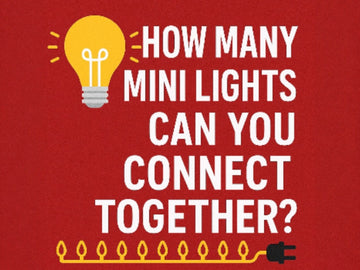🔌 How Many Mini Lights Can You Connect Together?
One of the most common questions from both professional installers and DIY homeowners is:
“How many mini lights can I safely connect together in one run?”
Whether you’re wrapping a tree, lining a fence, or outlining a roofline, knowing how many sets you can string together helps you avoid electrical issues, extend your installs, and deliver clean, safe results.
💡 The Short Answer
- Each strand uses 4.8 watts
- Maximum recommended connection in one continuous daisy chain: Up to 45 sets before returning to a power source
- Voltage: Standard 120V outdoor outlet
- Wire gauge: 18 AWG
- A typical U.S. circuit provides 15 amps / 1800 watts, meaning one outlet can technically power up to 265 strands (4.8 watts × 265 = 1,272 watts)
However, the real limitation isn’t how much power your outlet can supply—it’s voltage drop.
As you string more lights together, the longer the wire becomes, and the more voltage is lost due to resistance. This can cause the end of the line to appear dim, flicker, or fail completely.
That’s why we recommend only 45 strands per daisy chain run, even though the outlet can handle more overall. You can start additional 45-strand runs directly from the same power source using plug stackers or multi-outlet extension cords.
🧠 Why the 45-Strand Limit?
Even with efficient LED mini lights, going too far from the outlet in one long chain causes:
- Voltage drop (the end of the line gets dim)
- Circuit instability
- Inconsistent light performance
Every foot of cable adds resistance, and after a certain length, your lights simply don’t get enough power to run properly—even if wattage isn’t maxed out yet.
The fix: start fresh. Don’t daisy chain more than 45 strands in a row. Instead, stack multiple plug-ins at the power source and run up to 45 strands per output.
This lets you stay within safe limits, keep brightness consistent across the whole project, and avoid callbacks or troubleshooting mid-season.

🔧 Pro Installer Tips
Professional installers almost never rely on store-bought extension cords. Instead, they create their own layout using:
- SPT-1 Zip Cord – Custom length wire that blends in and hides easily
- Male & Female Vampire Plugs – Create exact plug locations where you need them
- Photocell Timers – Automate on/off without touching the system
This allows you to power multiple independent 45-strand runs cleanly from one source, using plug stackers or splitter cords for a central, discreet power hub.
❓ What Happens If You Go Over the Limit?
If you string more than 45 sets together in a single daisy chain, even though the outlet technically has enough power, you’ll likely see:
- Lights flickering or dim at the far end
- Breakers or GFCIs tripping intermittently
- Decreased product lifespan or even damage in rare cases
Always design your layout with distance in mind—not just wattage.
📏 Plan Your Power Layout
Before install day, sketch out your setup and identify:
- The total distance of each section
- Where the power will come from
- Where you’ll need to return to power (every 45 strands)
It’s common for pros to use one outlet and split it at the source—running two or three 45-set chains from one zip cord hub with stacked male plugs.
Not only does this look cleaner, but it keeps each leg of the job within safe limits and helps your lights shine bright all season long.
✅ Recap
- Each strand = 4.8 watts
- One outlet (15 amps) can handle up to 265 strands total
- But due to voltage drop, only connect 45 in a row before returning to power
- Stack plugs or split at the power source for multiple safe runs
- Use zip cord and vampire plugs for clean, professional installs
Need help planning your layout? Our team of real installers is here to help. Reach out with your project specs and we’ll walk you through it.
LightsAtWholesale.com — Built for Installers, by Installers.






